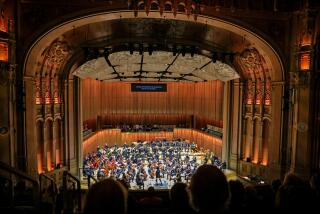No Clones, Please: Give Us the Original
- Share via
It would simply be unthinkable to build the Walt Disney Concert Hall without its architect, Frank O. Gehry, making the key decisions. Construction will be the continuation of the design process that Gehry began seven years ago; and it is shocking to read that there is only lukewarm support for Gehry’s carrying out the process. To turn it over to Dworsky Associates, the firm that did the working drawings, and Eli Broad, cochairman of fund-raising for the hall, would achieve the mechanical outlines, a close reproduction or a clone of the project, difficult to distinguish from the “original,” but a forgery nonetheless.
Beneath the surface throbs a deeper issue concerning the region, namely the willingness to accept the mirror image, the copy, as equal to the original; the use of art as a source to be replicated for business and real estate interests.
Controlled use of art has put in place images of lasting cultural significance. Such forms engender changes in the social and economic landscape, shifting the sands of society around them to create social stratification and spatial differences that fuel real estates urges.
What is not said about the current situation in Los Angeles is that this series of major new public projects, notably the Getty Museum, the Roman Catholic cathedral and the Disney Hall, is different from those in the recent past. These are working out a means of representing a new sense of public life. The Los Angeles Central Library designed by Bertram Goodhue began this tradition of representing in stone the multiple cultures that make up the city. Despite their diversity, the new efforts are each committed to public life, as opposed to the representing of private dreams in the form of hillside homes and trendy restaurants.
What is at stake is the regional unconscious, fulfilling the continuing need for ritual, for things with a physical presence that evoke “awe.” (Not because of hugeness or novelty like the New York, New York Hotel in Las Vegas, but because they tap the innate feeling that we have for the primitive.) It would be tragic to turn the concert hall into a sibling of another Vegas spectacle. It is critical that we address this need in an inclusive manner, so that the territory remains open enough to incorporate the impulses of a broad-based, multiethnic, polymorphous culture.
For several centuries in Europe, classicism suited this role as a language of design. At the end of “the war to end all wars,” modernism was invented to suit the capitalist need to create a corporate culture to supplant the industrial economy.
The consequences of avoiding recognition of the power of the unconscious and the need for something other than the functional and rational have been immense. We have seen the structure of family and community vaporize, lost our civil culture, surrendered rule of the urban order to the automobile and, perhaps most of all, allowed domination of the unconscious by television and film, luring it into a mad cacophony of consumerist urges.
I may have some misgivings about Gehry’s design, but at least it is conceived as a work of art that recognizes the continuing need we have for symbols that retain some form of the primitive tribal aura of religion and ritual. The problem is to define ritual in a way that is not colonized by tribal interests, whether Anglo-Teutonic or Mesoamerican. What other place is there on the planet to work out this amazing premise? Where but the Disney hall, in which a new consciousness about the roots of the classical impulse in music allows it to span all cultures, to be performed as a global discipline involving the musical tang and melodic nuance of polycultures?
The proposal to treat this building as the equivalent of a high-tech shopping mall that can be built on the basis of the working drawings without architecture goes to the heart of the problem. It may be possible to disguise the differences between a Gehry building and a Dworsky clone. But a mechanically reproduced clone it would be, and the risk of the loss of spirit--the heart of the project--seems to be of little consequence to the project’s overseers.
Should they go ahead as planned, there is danger that the project will end up as no more than another real estate anchor for downtown, like the Convention Center and the Sports Arena. It would be an “airhead” building listed as an attraction in guidebooks but not worth a second look or a meditative moment, lacking the presence to confront or be confronted by the “prepared mind.” That truly would hasten the decline of the city, rather than aid in its recovery.
More to Read
The biggest entertainment stories
Get our big stories about Hollywood, film, television, music, arts, culture and more right in your inbox as soon as they publish.
You may occasionally receive promotional content from the Los Angeles Times.










